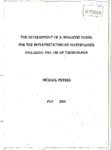The Development of a Semantic Model for the Interpretation of Mathematics including the use of Technology
| dc.contributor.supervisor | Graham, Ted | |
| dc.contributor.author | Peters, Michael | |
| dc.contributor.other | School of Engineering, Computing and Mathematics | en_US |
| dc.date.accessioned | 2010-11-03T10:04:09Z | |
| dc.date.available | 2010-11-03T10:04:09Z | |
| dc.date.issued | 2010 | |
| dc.date.issued | 2010 | |
| dc.identifier | 922775 | en_US |
| dc.identifier.uri | http://hdl.handle.net/10026.1/292 | |
| dc.description.abstract |
The semantic model developed in this research was in response to the difficulty a group of mathematics learners had with conventional mathematical language and their interpretation of mathematical constructs. In order to develop the model ideas from linguistics, psycholinguistics, cognitive psychology, formal languages and natural language processing were investigated. This investigation led to the identification of four main processes: the parsing process, syntactic processing, semantic processing and conceptual processing. The model showed the complex interdependency between these four processes and provided a theoretical framework in which the behaviour of the mathematics learner could be analysed. The model was then extended to include the use of technological artefacts into the learning process. To facilitate this aspect of the research, the theory of instrumentation was incorporated into the semantic model. The conclusion of this research was that although the cognitive processes were interdependent, they could develop at different rates until mastery of a topic was achieved. It also found that the introduction of a technological artefact into the learning environment introduced another layer of complexity, both in terms of the learning process and the underlying relationship between the four cognitive processes. | en_US |
| dc.language.iso | en | en_US |
| dc.publisher | University of Plymouth | en_US |
| dc.subject | Semantic model | |
| dc.subject | Semantic reasoning | |
| dc.subject | Syntactic reasoning | |
| dc.subject | Conceptual reasoning | |
| dc.subject | Parsing Mathematic Constructs | |
| dc.subject | Technology | |
| dc.subject | Instrumentation | |
| dc.subject | Mathematics Education | en_US |
| dc.title | The Development of a Semantic Model for the Interpretation of Mathematics including the use of Technology | en_US |
| dc.type | Thesis | |
| dc.identifier.doi | http://dx.doi.org/10.24382/3663 |
Files in this item
This item appears in the following Collection(s)
-
01 Research Theses Main Collection
Research Theses Main


